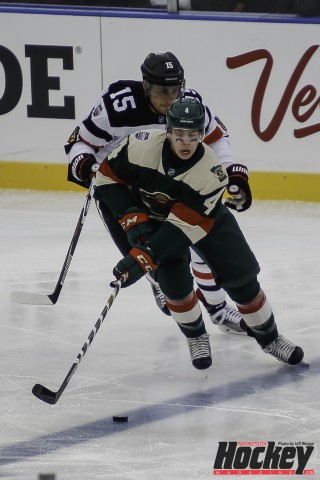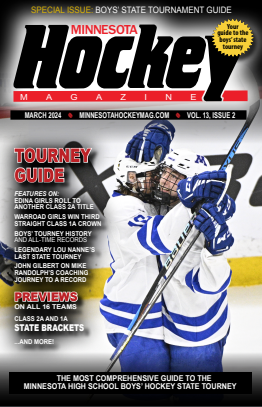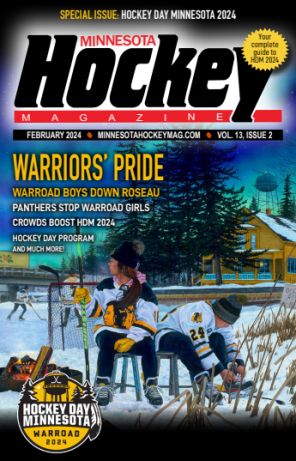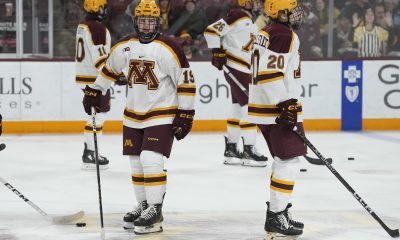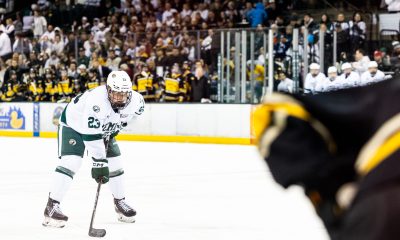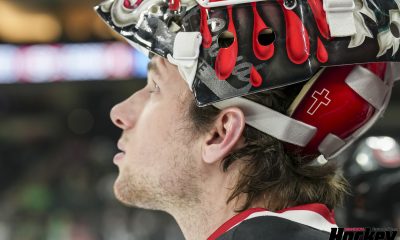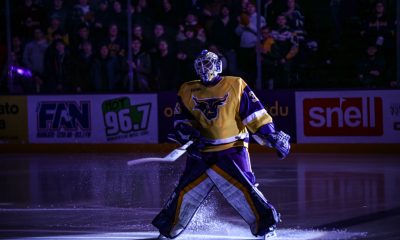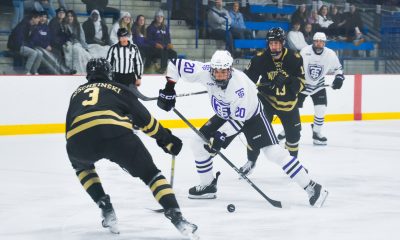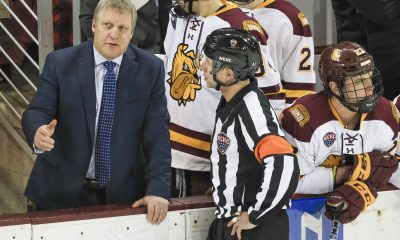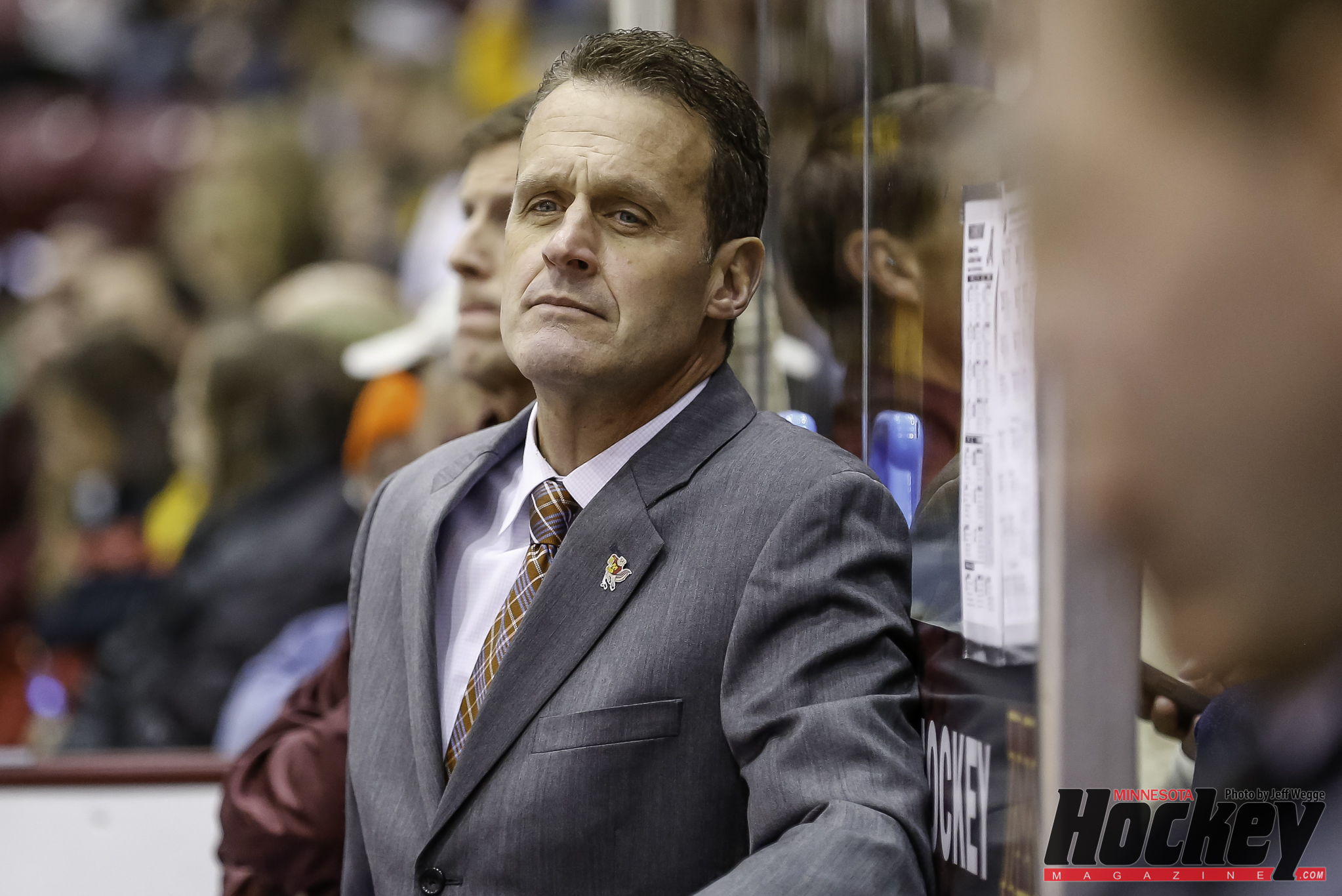
Minnesota assistant coach Mike Guentzel keeps tabs on his defensive corps during a Nov. 9, 2014 Gopher win over Notre Dame at Mariucci Arena. (MHM Photo / Jeff Wegge)
Mike Guentzel nearing two decades of forging NHL defensemen
Northern Minnesota’s Mesabi Range was not on anyone’s radar during negotiations determining the demarcation between the United States and Canada. The land could just have easily ended up as part of Ontario instead of Minnesota, but the arrowhead was allocated to the USA and ended up producing over 3 billion tons of iron ore. That stroke of fortune sparked a mining boom and families took root as Minnesotans in Duluth, Grand Rapids, Hibbing, Two Harbors, Eveleth, Virginia, Colerain, and Marble.
Many of these Minnesotans endured their Iron Range winters by playing hockey, and for one hockey player from Marble, it sparked the opportunity to wear the ‘M’ playing college hockey at the University of Minnesota.
“I’m a Northern Minnesota kid who graduated in 1981 from high school and there were two Division I programs in Minnesota,” said Mike Guentzel. “I’d never seen a Gopher game, but I wanted to play for the Gophers.”
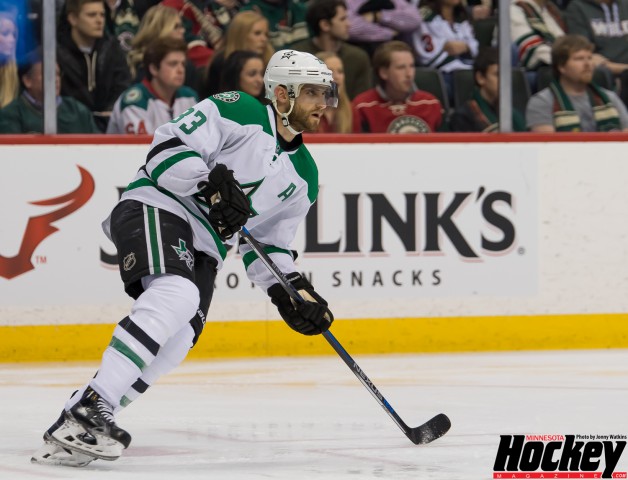
Fellow Iron Ranger Alex Goligoski of the Dallas Stars benefited from Guentzel’s training from 2004-2007. (MHM Photo / Jonny Watkins)
Guentzel was a three-sport athlete who made his mark at Greenway-Coleraine High School playing quarterback for the football team, as a first-team all-state defenseman for the hockey team, and on three baseball teams that finished third in the state tournament. The Iron Range’s second-leading scorer in 1981 was selected in the seventh round by the New York Rangers in the NHL Draft and then headed to Minneapolis to play for Brad Buetow that fall.
The adjustment to college hockey wasn’t an easy one for Guentzel, who scored 43 high-school goals, as he didn’t see the ice for the first 20 games of his freshman season.
“It was everybody from my high school coach, to my parents, to the coaching staff, to whoever else. It was their fault I wasn’t playing,” Guentzel said. “And realistically after a while, I realized it was my fault. I’m not prepared for this. I’m not ready for this. I have to make adjustments in my game.”
The freshman learned that season the benefit of finding a ‘B’ game and attached himself to roles less glamorous than quarterbacking the power play. Focusing on defending, penalty killing, shot blocking, and complementing his defensive partner’s game became his emphasis and allowed him to develop from there.
Guentzel persevered through the crucible of his first season, eventually captained the Gophers in 1984-85, and graduated with his degree in business and human relations. He had brief professional stints in the IHL with the Salt Lake City Golden Eagles and in the AHL with the New Haven Night Hawks, but knew he wanted to coach more than play professional hockey.
Guentzel spent six seasons coaching in the USHL and landed back at Minnesota as an assistant with head coach Doug Woog and coaching Mike Crowley in 1994. Starting the next season the Gophers went on a run of 12 consecutive NCAA appearances, and each team featured puck moving defensemen who could skate, flash stick skill, and get involved in the rush.
Minnesota Land of 50,000 Hockey Players
Last winter, Minnesota USA Hockey Registrations hit 55,450 with over 7,000 bantams actively playing association hockey. Recruiting season starts earlier every year as college coaches work to identify the 100 Minnesota players from each age group that will eventually earn spots on a Division I hockey roster.
Guentzel certainly has a good idea about what it takes, his three sons all earned opportunities to play Division I hockey. Ryan Guentzel was a forward for Notre Dame, Gabe Guentzel a defensemen at Colorado College and Jake Guentzel played forward for Nebraska-Omaha. He also knows what it takes because the University of Minnesota has had nine players represent them in the NHL this season. The nine Gopher defensemen (Paul Martin SJS, Nate Schmidt WSH, Alex Goligoski DAL, Seth Helgeson NJD, Erik Johnson COL, Nick Leddy NYI, Aaron Ness WSH, Mike Reilly MIN, and Brady Skjei NYR) is the most among all NCAA hockey programs this season.
“Our youth coaches put kids who have good ability on the back end,” Guentzel said. “Historically I think we’ve done a better job in our state of developing elite skating, puck-moving defensmen, than we have goal scoring true bona fide forwards. We’ve always embraced a style of puck movers, mobile defense, active defense on the rush. It kind of goes hand in hand with the way we want to play.”
While Paul Martin didn’t start getting recruiting letters until his sophomore year of high school, most elite talents these days are getting recruited and committing as bantam hockey players. Guentzel likes to get as many looks at these young players in competitive situations as he can, whether it’s USA Hockey Festivals or State Bantam Championships to see how players defend, and take pressure against a forecheck. Gopher assistant coach Grant Potulny is also on the road a lot ‘fox scoping’ players for the staff, looking for agility in their foot speed, how they turn, and stick skill.
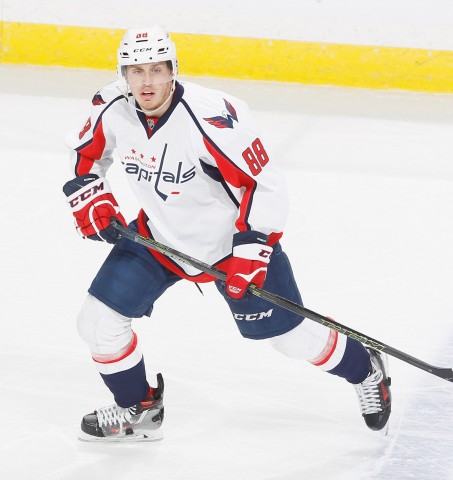
Washington Capitals D Nate Schmidt blossomed under Guentzel between 2010 and 2013. (Minnesota Wild / Bruce Kluckhohn)
“For whatever reason Minnesota develops a lot of defensemen, so you have a big pool,” Potulny said. “Now you get a chance to work some of the guys at the top of that pool and Mike does a really good job with them.”
Guentzel had his eye on Nate Schmidt during his sophomore season at St. Cloud Cathedral, and Guentzel was the main recruiter for Schmidt.
“I wasn’t the biggest U of M fan growing up, I can say that now, my family had season tickets to Husky games…” Schmidt said. “But one of the coolest things he did was he slid a piece of paper across from me after we got done talking about what his plan was for me. The piece of paper had all the guys names on that he had ever coached, whether they were playing or not, wherever they were. Here are all the guys that have made it, here are the guys that are playing pro at some level, and here’s the guys that didn’t make it, but are out doing other things.”
That moment was huge for Nate deciding his future, but like most recruits, he had no idea exactly what he was in for.
Steel Sharpens Steel
While iron ore is the raw resource extracted from Iron Range, it is brittle until forged into steel. And it isn’t steel until after it’s mixed with cooked coal, limestone and blasted with temperatures up to 1600 degrees. Defensemen don’t get blasted with quite the same temperatures at the University of Minnesota, but the pressure of playing the blue line at Mariucci Arena is still intense.
“We allow our defensemen to be very active from an offensive standpoint, that’s the expectation,” Gophers head coach Don Lucia said. “And Coach Guentzel, I don’t think there’s a better coach as far as developing the defensemen than what he does. He’s very demanding, he pushes the guys, whether it’s video or practice–he’s very honest and blunt with them. I think they respect that. He pushes them to be the best they can be.”
Guentzel knows that every time players jump a level it’s a step, and no one can tell how many games it will take for players to adjust to the speed, quickness, and strength. He just knows it will take time–especially in the modern game putting more emphasis into structure, defense and goaltending than ever before.
Current Gopher Jake Bischoff says his position coach is huge on the details that might go unnoticed, but making sure to shoulder check on retrievals to find your wingers, and taking quick strides after getting the puck to see your options are big points of emphasis.
“Every little detail in practice he’s on you about it, and if you don’t do it, you’ll hear from him,” Bischoff said. “I think then when it comes to game time, it’s automatic, you do all that kind of stuff. It definitely makes it easier out there.”
And practice isn’t the only place Guentzel lets his players know how they’re doing.
“Video Sessions… I remember those quite well actually,” said Schmidt.
Mike Reilly said the defensemen gather for position video review weekly for about half-hour to 45-minutes, just after practice early on in the week. Reilly specifically remembers coming into the session after what he felt was a pretty good weekend and then popping up on the screen five or six plays, the most out of any other d-man for miscues.
“He came in, just wanted more of me, and demanded more, Reilly said. That’s how he is and how he goes about his business. He’s really good communication-wise, he’ll let you know if you’re playing well or not. He’s not going to go around the corner to try to BS something about you, why you wouldn’t be playing. He’s going to tell you straight up.”
Research and Facilities
After World War II, the high grade ore in Minnesota was nearly gone and it looked like lean times ahead for the Iron Range. However, University of Minnesota professor Edward Davis had been researching a way to make taconite pellets out of waste rock. His research rejuvenated mining in Minnesota and gave the economy another boost through the 50s, 60s, and 70s.
The Minnesota hockey program has relied on boosts for their program as well. The move across the street from old Mariucci Arena to new Mariucci Arena in 1993 expanded the seating capacity from 7,000 to 10,000. The move also put the Pride on Ice on a 200’ x 100’ Olympic Ice sheet. The ‘big ice’ has drawn the ire of more than one NHL scout because its extra size compared to the 85’ wide NHL rink changes the evaluation process.
“In my opinion you have the puck more on your stick, you can make more decisions, you have a better chance to skate, you have a better chance to be more involved in the offense, and you have to learn to take away time and space on a [bigger] rink,” Guentzel said.
Even with the extra time and space, it takes some players a while to realize the difference and when they finally do it’s a game changer for them.
“I never really realized how much time I had until I was almost gone,” Schmidt said. Until about my junior year of Christmas I finally realized if you beat the first forechecker and get the net, the rink is so big it’s hard for the next layer to get to you. Now, if you do that on the smaller rinks, it actually draws the second guy away from his check. And if you can draw another guy away and make a play, that just opens up a lot more space for somebody else.”
The next boost for Gopher Hockey will be a renovation to their locker room, team areas, and training facilities at Mariucci Arena. The process starts April 11, nearly $5 million of donated funds will be invested into the effort, and the team’s strength and conditioning coach Cal Dietz is excited about all the new toys coming.
“We’ll have equipment coming from all over the world, scientific equipment, to make this the best facility that I’ve ever known,” Dietz said. “There won’t be another facility like it, and it will be 10 years ahead of anybody else who builds anything.”
Dietz is well respected by the coaching staff as a major factor in developing athletes and he utilizes data from blood tests, gyroscopes, accelerometers, magnetometer, and brain waves to help maximize performance. The data he gathers helps him develop the measurable athletic ability of the players and provides feedback to the coaching staff on the proper training load. Schmidt said that Dietz is so well respected in NHL circles that when the Washington Capitals training staff learned he was going to be working out with Dietz over the summer, they said it’d be okay if he didn’t use the program they gave him.
“College hockey is a man’s game, everyone out here is big and strong, and so working with Cal is really nice,” Michael Brodzinski said. “We get two or three times a week in the weight room with him during the season, and I think it’s really paid off getting us faster and stronger.”
Mr. Gopher
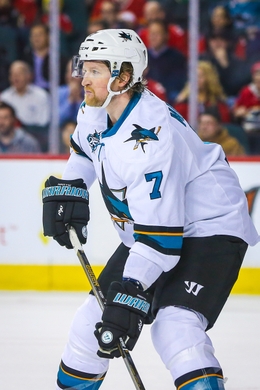
Paul Martin honed his skills under Guentzel and won two national titles while a Gopher from 2000 to 2003. (Mandatory Credit: Sergei Belski-USA TODAY Sports)
While Guentzel takes a lot of pride in the program, he did step away for a three-year period from 2008 to 2011 spending a year as an assistant at Colorado College, a year as a head coach in the USHL for Des Moines, and then a year as an assistant at Nebraska-Omaha. At the time he told the Minneapolis Star Tribune, ”it was a time and place where maybe he should step away.“
Then in 2011, the two Iron Rangers came to an understanding.
“We’ve worked together a long time,” Lucia said. He’s kind of Mr. Gopher around here, and nobody has more passion and bleeds it more than he does. That was one of the things when I came, I wanted him to stay and with him coming back, just the confidence in him, and his ability and what he means to the program.
“Since Mike has been around with program, before me and with me, there’s been a whole lot of winning going on.”
The players are also grateful to have worked with a coach that just finished his 19th season at the University.
“He wants the program to do well as well as the players they bring in,” Martin said. “He teaches you the right way to carry yourself and how to play hard. He’ll yell at you, but at the same time then he’ll tell you what you need to work on and work with your game, he’ll stay after. He has high expectations, which he should when you come into that program it has a lot of history and tradition that you need to uphold.“
Eric Vegoe is a writer based in Minneapolis who has written for Hockey's Future, the Cedar Rapids Gazette, and has been published in the Chicago Tribune. He has covered the University of Minnesota men's hockey team since 2007 for GopherPuckLive. Follow him on Twitter at @evegoe.





